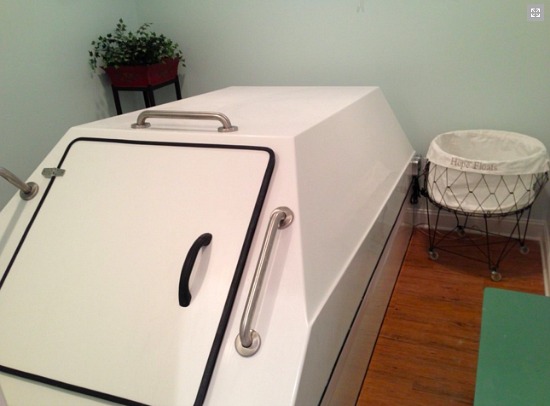 Off the Beaten Turf: The Sensory Deprivation Tank
Off the Beaten Turf: The Sensory Deprivation Tank
✉️ Want to forward this article? Click here.

The sensory deprivation tank at Hope Floats.
In this edition of Off the Beaten Turf, we tried out an experience that was a welcome break from our typical plugged-in, email-checking state: spending an hour floating in the pitch-black, soundless peace of a sensory deprivation tank.
As the name suggests, the tank frees you from (almost) all sensory stimuli by allowing you to float in body-temperature salt water in a quiet, dark chamber. The tank was developed by scientist and physician John Lilly in the 1950s as a way to test the effects of sensory deprivation. Soon, Lilly and others realized the meditative and mind-expanding potential, and the tank took off as a form of therapy.
Proponents of the sensory deprivation tank believe that by ridding your body of sensory stimulation your mind will be free to reach usually-inaccessible levels of relaxation. Some believe that this opens the door to creative thinking, problem solving, powerful visualizations or more spiritual experiences.
In the DC area, interested floaters can visit Hope Floats. Hope Floats opened up just four months ago in a most off-the-beaten location: the basement of a single-family home in suburban Bethesda. The owner has a single tank that can be rented for 60 or 90 minutes, but is currently looking for a retail space where she can put in two tanks, as well as a non-enclosed flotation pool.

Right now, the spa environment doesn’t quite exist. The waiting room doubles as the family rec room, complete with basketball nets, and the family dogs happily sniff around. But the benefits of the tank are not diluted, and interested patrons were constantly filing through to spend $70 for one hour in the tank.
After signing a waiver attesting to my mental health, I took a few preliminary steps: scrubbed up in a shower, donned a robe, put in ear plugs, and then went into a small room with the tank, which is essentially a shallow bathtub that is completely enclosed. Upon entering through a hatch (sans robe), I took a supine floating position in the tub and closed the door to complete darkness. The water is saturated with Epsom salt, which increases density to make you more buoyant.
My body floated with no effort and my face was completely out of the water (though my ears were submerged). Breathing was easy, though there is a little humidity in the tank. The pitch-black darkness somehow counteracts any claustrophobia, because you are not aware of the walls or of any boundaries. There’s a bit of a learning curve, which is why Hope Floats offers a second “dip” for free; most newcomers spend 15-30 minutes adjusting before they can completely relax, the owner told me, but the second time, they can sink right into it.
On my first attempt, it indeed took me several minutes to adjust to not having to adjust. My limbs also bounced gently off the walls for a few moments before I reached an equilibrium in the center of the tank. Though the water supported me, it took a little while to give in to that feeling and release all of my muscles. After ten minutes, I realized I could release my straining neck; after another ten, I found a position for my arms that released the tension in my back. After that point, I began to feel less distracted and more relaxed.
Eventually, many people start to lose realistic awareness of their bodies. Maybe their limbs become heavy, or the space begins to feel vast and endless, rather than compact. Some claim to experience hallucinations.
After reaching the relaxation point, everyone in my group went on to have slightly different experiences. One person was able to relax his mind into a meditative state for about 30 minutes and came floating out of the room smiling like the Buddha. The other appreciated the healing properties of the floating mechanism, which relieved her long-standing back pain for at least a day.
I had an undoubtedly relaxing experience, but may have a reason why I wasn’t quite able to reach a detached meditative state. When my awareness of all other sensory input dropped away, I was left with one, cute, spontaneous and unceasing distraction: my six-month-old fetus wiggling and kicking in my womb.
In a world that invented Google Glass, full of sensory stimulation, many of us spend our days constantly reacting to emails, tweets, text messages and other sorts of electronic beeps. And even the most relaxing, off-the-grid vacation involves some sort of sensory activity. When all the stimulation is shut off, what will you be left to think about? If you’re interested in finding out, take a trip up to the sensory deprivation tank at Hope Floats.
See more Off the Beaten Turf:
- Off the Beaten Turf: DC’s Tastiest Chinese Restaurant?
- Off the Beaten Turf: DC’s Newest Mini Golf Course
- Off the Beaten Turf: DC’s First Gin Distillery
- Off the Beaten Turf: Quarry House Tavern
- Off the Beaten Turf: Fab Lab DC
- Off the Beaten Turf: Uncle Chips Has More Than Just Cookies
- Off the Beaten Turf: DC’s Supper Club
- Off the Beaten Turf: The Cuban Poster Gallery
- Off the Beaten Turf: The Dupont Underground Tour
- Off the Beaten Turf: Spanish Steps
- Off the Beaten Turf: The U.S. National Arboretum
- Off the Beaten Turf: Blind Dog Cafe
- Off the Beaten Turf: Hana Japanese Market
- Off the Beaten Turf: A. Litteri
See other articles related to: off the beaten turf
This article originally published at http://dc.urbanturf.production.logicbrush.com/articles/blog/off_the_beaten_turf_bethesdas_sensory_deprivation_tank/7475.
Most Popular... This Week • Last 30 Days • Ever

Today, UrbanTurf offers a brief explanation of what it means to lock in an interest r... read »

An application extending approval of Friendship Center, a 310-unit development along ... read »

The 30,000 square-foot home along the Potomac River sold at auction on Thursday night... read »

A new report shows that asking rents across the DC region saw some of the largest dec... read »

Capital Bikeshare breaks a record; Trump potentially legalizes weed sales in DC; and ... read »
DC Real Estate Guides
Short guides to navigating the DC-area real estate market
We've collected all our helpful guides for buying, selling and renting in and around Washington, DC in one place. Start browsing below!
First-Timer Primers
Intro guides for first-time home buyers
Unique Spaces
Awesome and unusual real estate from across the DC Metro













